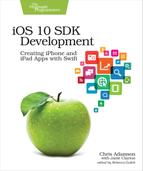What We’ve Learned
In this chapter, we learned about, arguably, the most essential UI element in all of the iOS SDK: the UITableView. By connecting a table view to a data source, we can create scrolling tables with our app’s data and present it in a familiar, convenient form to the user. And we’re not exaggerating when we say that downloading data from the Internet and putting it in table views is the bread and butter of many, if not most, iOS apps. Whether you’re looking at podcast episodes, tweets, airline flights, sports scores, documents to open, or what have you, it’s table views all the way down.
We also learned that the basic presentation offered by tables is pretty bare-bones, so we can perk things up with UITableViewDelegate functionality, or create custom table cells with our own layouts and designs.
Our sample app has taken a huge step forward, combining the downloading and parsing tasks of the previous chapter with the UI presentation of this one. We’re presenting real-world data in our app. The last major step is to reconnect ourselves with the audio player scene of several chapters back so that we can choose a podcast episode from this list and start playing it. In the next chapter, we’ll learn how to navigate between these scenes.
